The Kia Optima most likely came to your attention through the bombastic Super Bowl commercial in which many an eager character looked to take possession of it. Even Poseidon himself was forlorn as it was snatched from his salty grasp… By aliens. The reality is, while not as thrilling to warrant intergalactic conflict or the wrath of an ancient sea deity, as ads like this would lead you to believe, the Kia Optima is a good looking, comfortable sedan worth consideration.
On a recent Top Gear episode, the presenters made a passing comment on how ordinary 4-door sedans are becoming quite attractive looking, and pointed out the Optima as an example. This is true. This segment of cars may not be as luxurious as vehicles that cost twice as much as them, nor as flashy as sport coupes, but who’s to say that they had to be dull looking? The Optima’s front fascia continues Kia’s current design themes with sharp, upward angled headlights and a bowtie grille outlined with chrome accents. The chrome touch continues on the door handles as well as across the tops of the door frames, swooping attractively from the A-pillar all the way past the C-pillar and to the end of the rear wind shield.
The EX trim level is powered by a 2.4L 4-cylinder engine that, with the assistance of Gas Direct Injection, produces 200 hp @ 6,300 rpm. This is paired with a 6-speed sportmatic transmission that allows for sport-like transmission, but performs better when left alone to do its job.
On the inside, the Optima’s roomy cabin, for both front and back passengers, is covered in leather trim, with very little in the way of overtly plastic furnishings. The steering wheel is also leather-wrapped while the doors and center console is imbued with walnut-like accents, as well as on the shift knob. The wheel’s covered with controls to cycle through the radio preset, make and receive calls, and activate any voice recognition functions you might want to engage. The audio system has all the basic functions, but also includes SIRIUS radio accessibility as standard. The navigation system with rear camera display is a great option that makes much of the car’s features easier to control. Here, you can pair your phone or mobile device for hands-free calls and even stream audio over without the need for a physical connection. I did have a couple of incidents where the car didn’t seem to remember that my phone was paired, despite both devices saying everything was set up normally. I couldn’t tell which of the two were misbehaving, but it took two frustrating days for it to sort itself out again on its own, and the problem never arose again. The biggest feature of the interior is the panoramic dual sunroof. A button push will retract the shades to the middle, opening up the world around you, while the front of the two glass panels can open completely, or tilt in the moon roof setting. The sound system, an Infinity 8-speaker audio system Produces a good level of quality for all modes of media, including when the speaker phone function is in use.
Visibility through the front windshield was average, and the view from the back was slightly less so. Parallel parking was greatly assisted by the rear-view camera, but I found myself forced to rely on it more than I usually prefer to. The display had guideline graphics, but don’t take those as exact measurements. One parking scenario looked text-book through the camera, but when I stepped out of the car, I had enough space between it and the curb to riverdance. The Optima has some pretty substantial blind spots which made more than just parking a chore. Knowing this, I tried to take extra caution in my over the shoulder glances, but those proved difficult as well, allowing a couple cars sneak up on me in moments where I let my guard down. All in all, it was tricky and tedious to see around the rear corners.
Approaching the Optima with the proximity sensing key, the interior lights light up. The driver’s seat, once the car is started by push button ignition, will curiously slide forward and place you in the preferred drivers position and slide back when the Optima is switched off. This will become relatively unnoticeable after some time, but if the car is driven by someone else, some issues will arise. For instance, when the Optima was dropped off for my use, it appeared as though the delivery person was quite tall as the seat was very far back, so I slide it forward before I start the car, which then slid back again, having me to slide forward a second time, and then having it slide in reverse yet again when I shut it off. This crazy dance repeated itself when a shorter member of the AK staff drove the Optima down the block. The seat was maddeningly close to the steering column, and, knowing any adjustments I made before starting would complicate matters as it did before, I squeezed in, started the car, and then had the seat unceremoniously stuff me further into the leg well.
I’m still unsure as to what this function is for, or what Kia is trying to tell me. Are they suggesting I need more room as I egress from the vehicle? Is sliding the car forward presenting the controls to me, inviting me to drive? I don’t have the answer, but I suspect that my first guess is way off as the interior of the Optima is vastly capacious. Once I worked out an agreement with the driver’s seat, I had an incredible amount of room. Not only was there a great deal of leg room and head room, but a surprising amount of width for an individual as well.
The Optima’s sharp styling may lead you to believe that the mid-size sedan is as fun to drive as it is to look at, but if you are looking for an exciting drive, the Optima will disappoint you. I say this not to disparage the quality of the drive, but planting the pedal down for most overtaking will leave you coming up just a little short and a lot irritated. The independent, MacPherson strut front suspension and multi-link rear is set up to be more comfortable than sporty, and it is here where the Optima performs with aplomb.
Many of us like a little bite when we hop in the car to get somewhere, and the drive will occasionally be the best part of where you need to be, but most simply want to go home at the end of the day and not concern themselves driving, doing so only because they don’t have a rail system to shuttle themselves directly from office to their house. I can admit that I too often dread the ride back after a long day and would rather in these cases be chauffeured. The Optima won’t take you home automatically, but makes the task of driving less arduous for the weary. The 6-speed sportmatic transmission does the job fine without your input, and the optional navigation in the EX saves you from having to worry about directions too much, allowing you to concentrate on the immediate area, or whatever entertainment you happen to be enjoying.
I have to say that I got a lot of things done in the Optima on my daily drives. Often, when I’m driving, I’m really driving, and my concentration is on the performance of my ride and the awareness of those around me. In the Kia, the lackadaisical travelling allowed me to make phone calls via the Bluetooth speaker system that I may have otherwise forgotten and caught up on the news of the world by listening to the SIRIUS radio stations.
Though productive, I did often get particularly tired of all this comfort after a few days of running many errands. I often took to making phone calls to friends and family just because I’ve gone through all the radio stations and simply needed to speak to someone out of sheer boredom. Then there’s the moments where needed to really drive. I’m running late for something, I need that little extra bit of gunpowder in my commute to get around people not in a hurry, and as I said before, would often have to shy away from passing as the car wasn’t up for it, and when the Kia did perform, it felt very uncomfortable. The times where I needed a track sneaker, I had a leather dress shoe.
The Kia Optima’s 2.4L 4-cylinder engine is supposed to give a combined mpg of 27 mpg, and even features an “eco” mode that is meant to regulate throttle and gear settings, favoring fuel management over performance. In my time with the car, I seemed to average between 21 and 23 mpg and switching from eco mode to regular didn’t produce any noticeable change in either category. It seems that this mode is a very low level, background function that will probably save you a very low percentage of fuel costs over a long amount of time.
The trim level that I had been testing was the EX, the middle of three that include the base LX, and the higher SX. An option for the EX and standard in the SX is the 2.0 turbo i4 engine that puts out 274 hp. The starting price for an Optima with this engine is $24,700 while the EX with the non-turbo power plant has an MSRP of $22,700. The Optima EX with all its options totals at an MSRP of $27,440, including freight and handling.
The Kia Optima didn’t endear me to it, but I appreciated how seamlessly it integrates into your life as daily driver. I’d classify it as “average” but a high average, as it does everything it’s meant to do well with little fuss, and if you were to climb in another car after spending time with it, you’d suddenly find yourself missing the comfort and functionality the Optima quietly provides.
Words By – Alex Kalogiannis
Photos By – Jon Rouzier

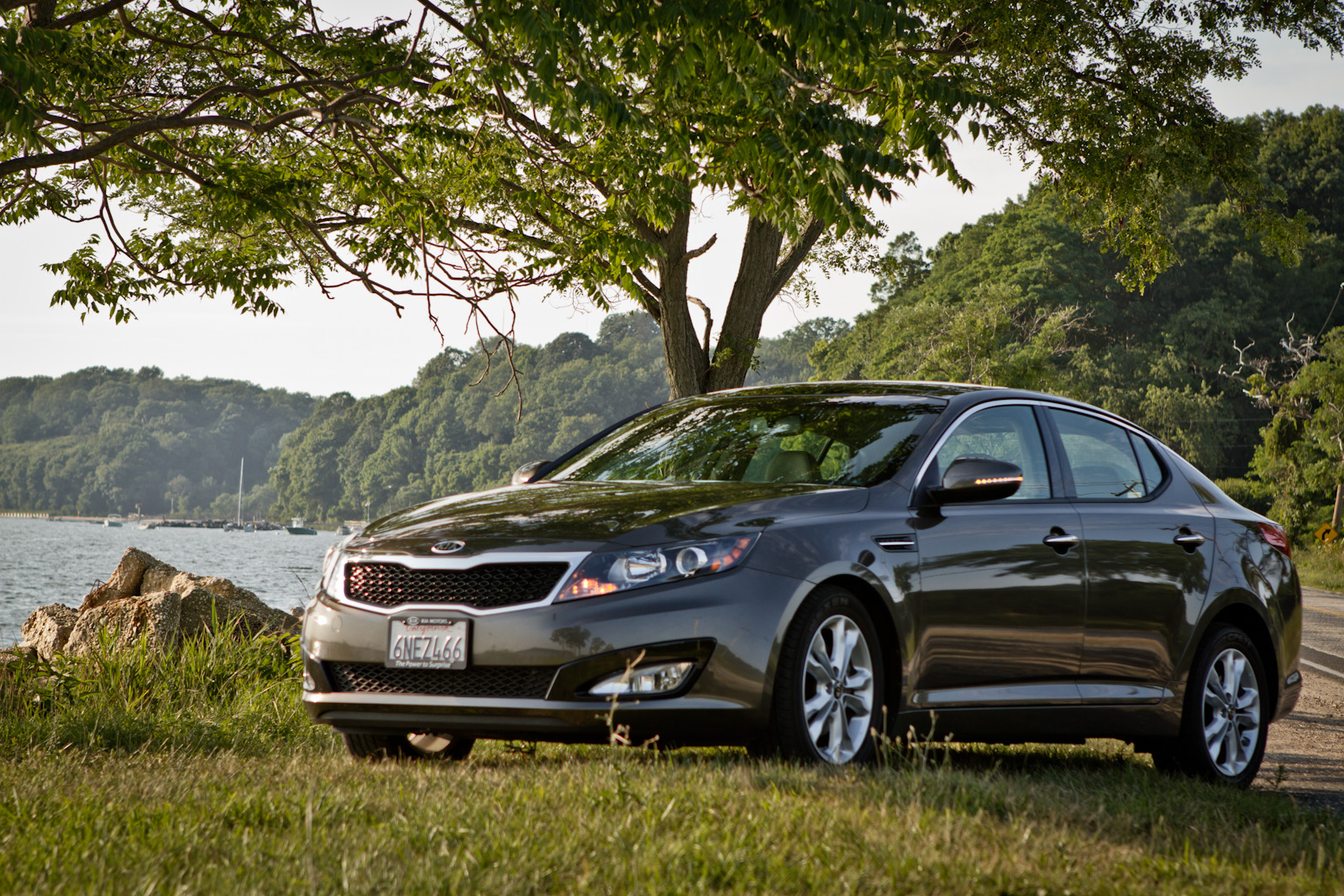

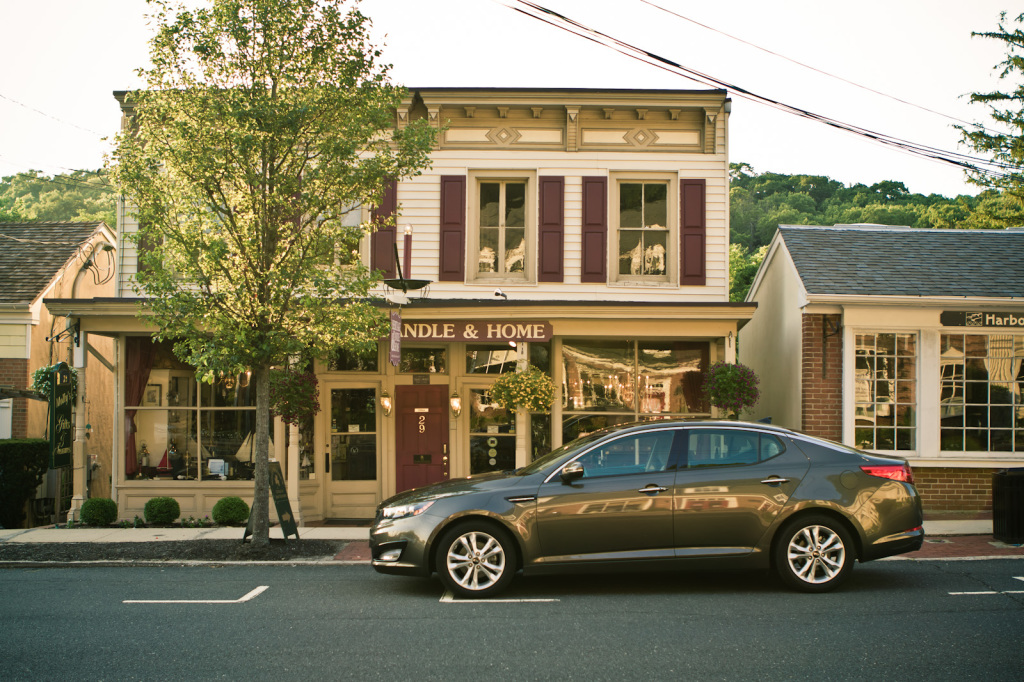
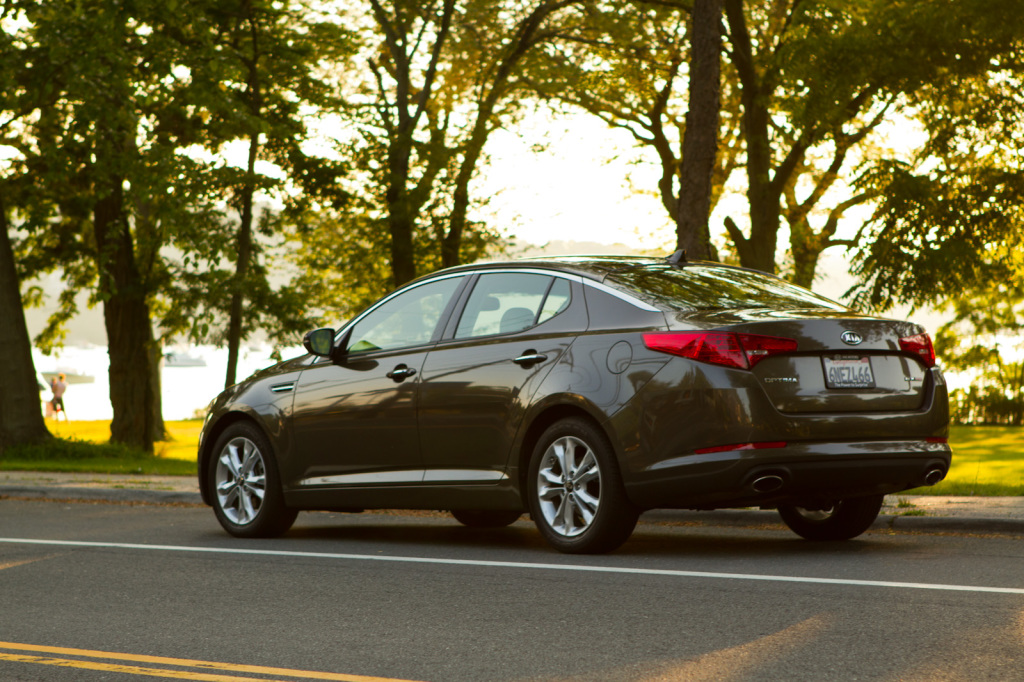
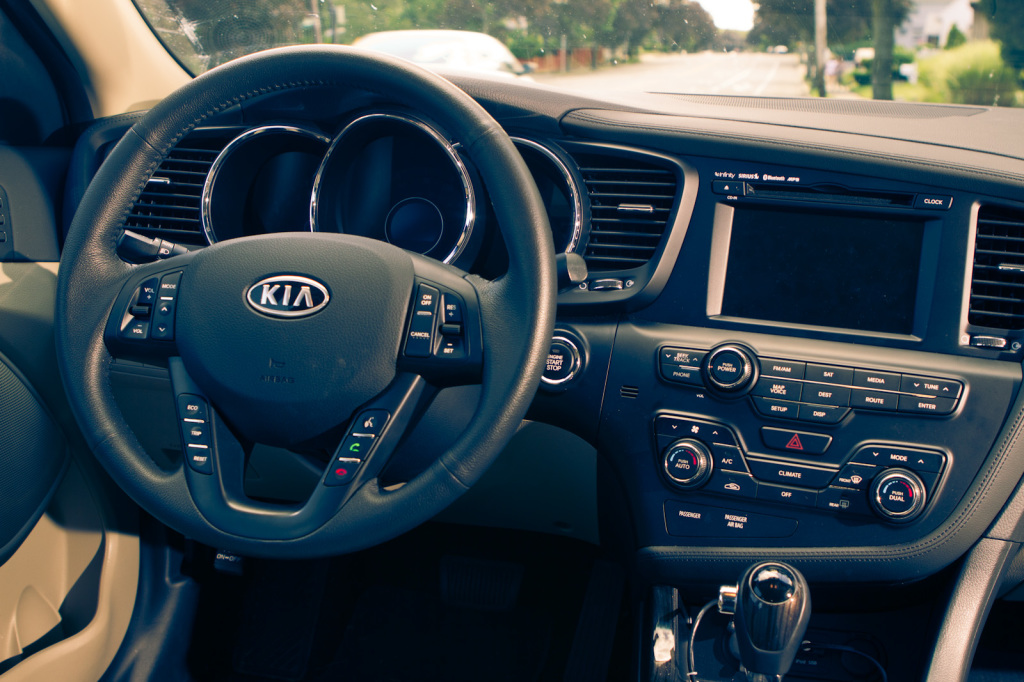
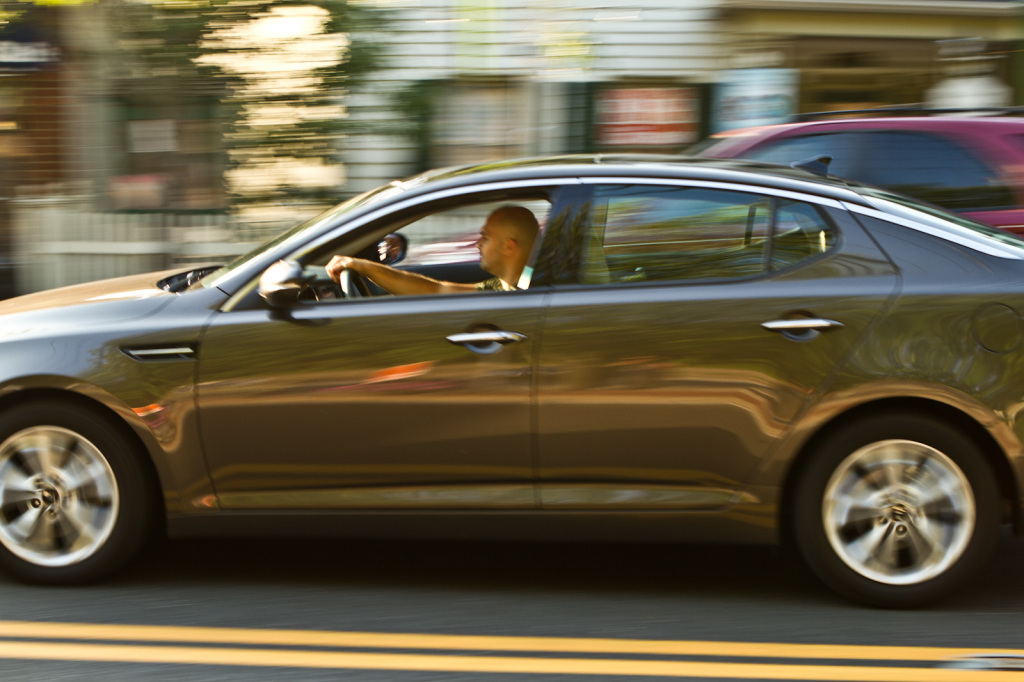
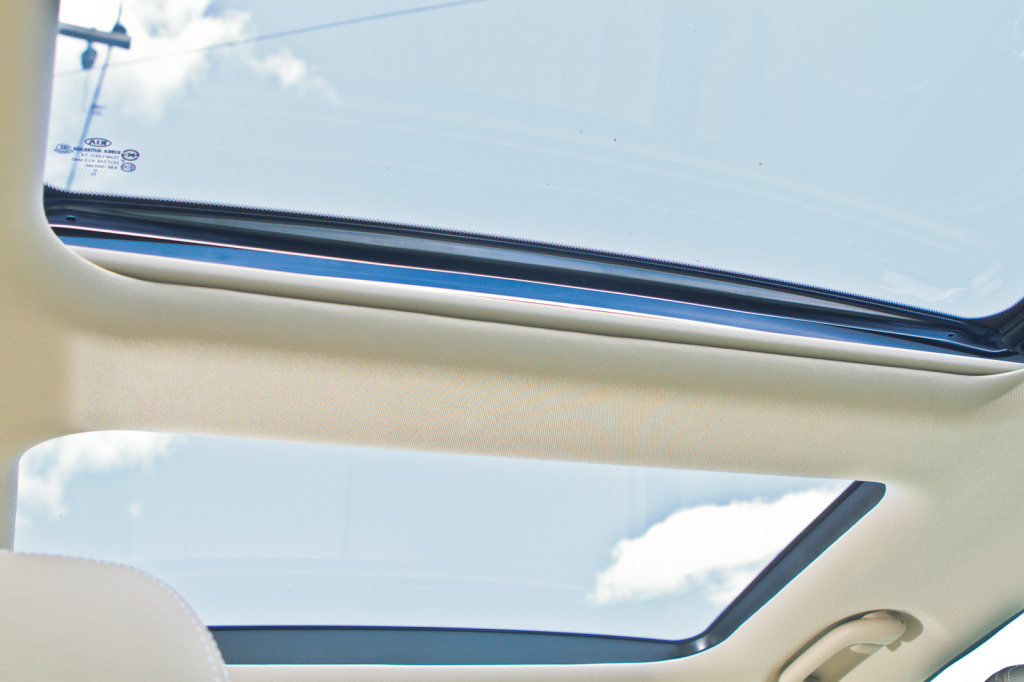


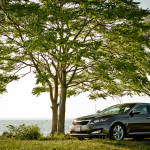
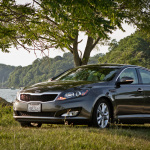


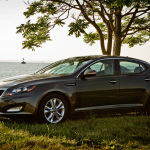


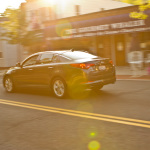


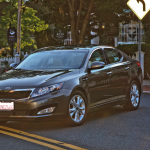





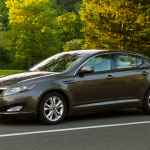
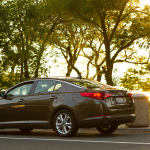
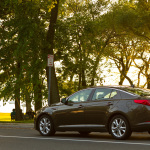
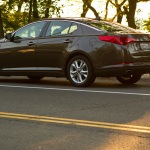


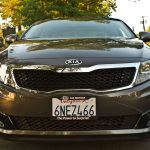


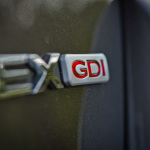
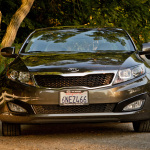
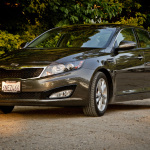
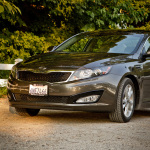

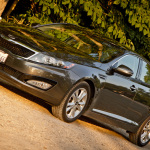
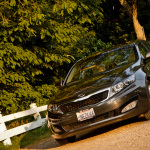
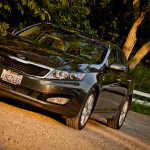

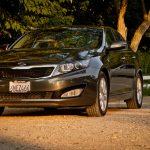
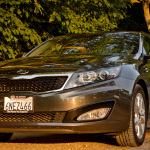

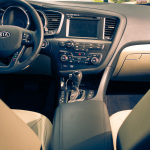
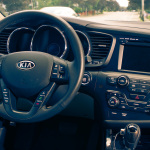

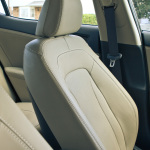
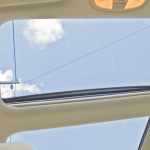

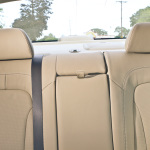


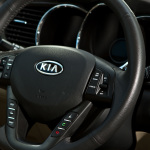

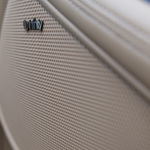
I will say this, half the experience of owning a “luxury sedan” (or one that pretends to be one) is the prestige of rolling up to the valet and handing over the keys with a sense of pride in the fine engineering and surely large price tag that comes behind it. That being said, this car just doesn’t present that “wow” moment. You look at it and think, “interesting, it looks good … i guess”. You also find yourself saying the same couple words at the end of any positive opinion about the car. “Its pretty well styled … for a Kia”. That condition is one that moves the bar against which the car is judged.